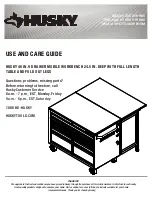
SECTION 1. SM192/716 STORAGE MODULE OVERVIEW
1-5
1.4.4 MEMORY CONFIGURATION
The Storage Module's memory can be
configured as either Fill and Stop or Ring style
memory. In the Fill and Stop configuration, the
Storage Module stops accepting data when its
memory is full. No data write-over occurs. In
the Ring Memory configuration (the default
setting), new data continue to be stored even
after the memory is full. New data are written
over the oldest data in the memory. The
Storage Module's memory configuration can be
changed using SMCOM or with Command 4 in
the CR10 *9 Mode.
1.4.5 BAUD RATES
When storing CR7, CR10, and 21X data, the
Storage Module is set for its default baud rate of
76,800/9600; baud rate matching is automatic
and requires no user intervention. Data transfer
takes place at 9600 baud.
With other devices, the baud rates of the device
and the Storage Module must be matched by
the user. Storage Module choices are: 300,
1200, 9600, 76,800, and 76,800/9600 (Section
4.1). With the CR21, the SM must be set to 300
baud. When using the Telecommunications
Commands, sending several carriage returns
will cause the Storage Module to match the
computer's baud rate (300, 1200, or 9600
baud).
1.4.6 FILE MARK
File Marks are used to separate data in the
Storage Module. A File Mark is automatically
placed in the SM's memory when the SM is
connected to a power source (datalogger or
retrieval interface) or when the datalogger
compiles a program containing Instruction 96.
For example, if the user has retrieved data from
one datalogger, disconnects the SM and then
connects it to a second datalogger, a File Mark
is placed in the data when the second
datalogger is connected. This mark follows the
data from the first datalogger and precedes the
data from the second.
A File Mark can be placed in the data from
SMCOM or the CR10 *9 Mode Command 3.
The Storage Module will not store back to back
file marks; if a File Mark is the last thing stored
in memory, a second file mark will not be
stored.
1.5 QUICK START-UP PROCEDURE
This Section describes the basics of storing and
retrieving of datalogger data. These operations
are discussed in detail in Sections 3, 4, and 5 of
this manual.
1.5.1 PREPARATION
Before putting the Storage Module into service,
connect it to a computer and use SMCOM to
reset the SM and test its battery.
If it is not possible to use a PC compatible
computer and SMCOM, the user must establish
communication between the SM, the available
computer, or terminal (Section 5) and reset the
SM using the Telecommunications Commands
(Appendix D) or use the *9 Mode in the CR10
(Appendix A).
1.5.2 PROGRAM THE DATALOGGER TO SEND
DATA TO THE SM
Instruction 96 is used in the datalogger program
to send data to the Storage Module. The SM is
connected to the datalogger with the SC12
cable. Each time Instruction 96 is executed,
Final Storage data accumulated since the last
transfer are sent to the Storage Module.
For the CR7 and 21X WITHOUT Instruction 96
the *4 Mode is used to enable output to a
printer. The CR21 automatically outputs printer
data at 300 baud each time data is sent to Final
Storage.
The DSP4 outputs printer data when the printer
function is enabled.
1.5.3 MANUAL DUMP
The *8 Mode in the CR10 or the *9 Mode in the
21X and CR7 can be used to transfer data to
the SM under keyboard control. All of the
above options are discussed in greater detail in
Section 4.
1.5.4 DATA RETRIEVAL
The simplest method of retrieving data from the
Storage Module is to use SMCOM. SMCOM is
contained in Campbell Scientific's PC208
software. It is written for IBM PC/XT/AT/PS-2's
and compatibles. If the user has another type
of computer, the SM telecommunications
commands can be used to retrieve the data.
Data retrieval (including interface devices) is
discussed in Section 5.










































